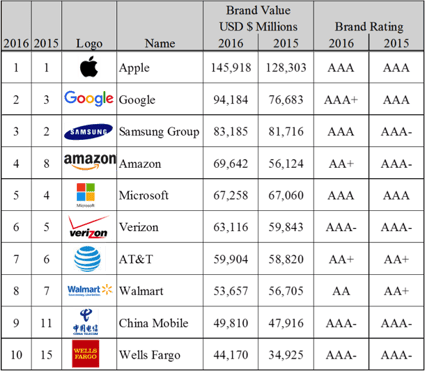December 1, 2016 | Business Growth Strategy & Strategic Planning
Brand Equity: How to Add Lasting Value to Your Company
A brand is more than just a product, logo, website, or tagline. A brand is all of these taken together to create an intangible effect amongst stakeholders (customers, prospects, suppliers, creditors, employees, government agencies, etc.). Building your company’s brand equity is often an integral part of your business strategy. A recent Forbes magazine article rated these top brands and their value to their respective organizations.

Brand equity is built on your stakeholder’s experience with your products and services. This experience, repeated over time, creates equity or value in your brand. And it serves as a reminder in your customer’s mind as to why they choose to do business with you as opposed to a competitor.
Brand equity fosters loyalty that builds a bridge between you and your customers. It is not easily broken by price discounting by competitors or the occasional product or service bump in the road. It is the quality that motivates your customers to recommend their friends or colleagues to you. Brand equity isn't just something you have; it's something companies build from the ground up. The key to building brand equity is to establish a pattern of loyalty from your stakeholders. And to do that, you have to improve your brand and customer experience levels. To help, here are seven steps to fashioning a brand equity strategy:
Position Your Product or Service as Unique and Reliable
Brand equity is built on your customer’s experience with your product. If your product or service is reliable, you’ll create brand equity. As customers use your product or service and get the results they expect, they will become loyal clients. Loyal customers may be willing to buy your product, even if the price increases. Loyal customers may stick with you product, even if they have a small customer service issue. These customers see a value in your product. Also, don't discount the importance of good customer service. Even with a great product, a bad customer service experience can help to create a negative brand equity situation resulting in customers avoiding your company.
Solve a Problem for Your Customer
Customers buy a product to solve a problem. The problem must be important enough that it motivates the client to find a solution. So, in essence, your company does not produce products or services, it produces solutions for your customers.
Companies don't produce products or services, they develop solutions to the market's problems. #branding #businessClearly Establish Your Firm’s Position in the Marketplace
Think of a single idea that describes your company to the marketplace. What unique way does your company fulfill this description. As an exercise, fill in this sentence: “We are the only company that solves this problem in this unique way.” Describe the problem and put the language in the sentence. Then, briefly explain how you uniquely solve the customer’s problem. This forces you to think clearly about your firm’s position in the marketplace. If you can’t complete each part of the sentence, you can’t explain your brand to customers and prospects.
Train Your Employees to Believe in Your Brand
Teaching your employees about your brand will increase their emotional connection to the company and help them understand their impact with your stakeholders. If your employees are invested in the brand, they'll be excited to talk about it with your customers. Don’t exclude your employees from the branding process. You should encourage them to provide you with feedback and to try their own ideas. If it's your employee's own idea at stake, they’re going to be far more invested in ensuring it is properly executed.
Tell Your Story
Stories get people’s attention and keep them engaged. Use a story to explain your brand and connect with your stakeholders with an emotional pull. If a prospect makes an emotional connection with your brand, they may decide to take action and buy your product. Give an example that explains how a customer was frustrated about a problem and explain how your product solved the problem.
Make Your Company Memorable
A customer’s awareness about your product is a critical factor in generating more sales. This is where your branding elements such a logo, a tagline and an inviting color scheme are important. Once created, these items are easy for people to remember and will bring instant recognition to your company. If possible, you may want to use these elements on all of your products and in every marketing and advertising message.
Measure Your Efforts
It’s important to remember that unless measured, you don’t know how well your brand equity is working. One way to judge the progress of your efforts is to survey your customers. Ask them what they think is your company’s message. You can also analyze how your search rankings and website traffic change as you brand your company. If you’re getting more activity that means that your efforts are making an impact. Finally, check your social media comments. Look to see if there are positive comments that indicate your product is solving problems for your customers. Satisfied customers will make positive comments on social media.
In order to build your brand equity you must be consistent and committed in your use of your branding elements. Building brand equity is a long-term proposition that needs to come from the top in order to be successful. Strong brand equity arises when a company makes a promise to their stakeholders and is committed to keeping this promise. Remember, it is often worse to break a brand promise than to have never made a promise at all.


Leave a Comment